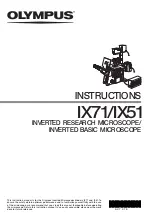
V
Sources of Noise
Darknoise
Dark noise is due to the generation of thermal dark elec-
trons N
d
, irrespective of whether the sensor is irradiated. Nd
statistically fluctuates about
N
d
. Dark noise is specified for
a PMT voltage of 1000 V; with lower voltages it progres-
sively loses significance.
Dark noise can be reduced by cooling the sensor. However,
the reduction is significant only if N≤N
d
, e.g. in object-free
areas of a fluorescence specimen. In addition, the dark noise
must be the dominating noise source in order that cool-
ing of the detector effects a signal improvement; in most
applications, this will not be the case.
Additional sources of noise to be considered are amplifier
noise in sensor diodes and readout noise in CCD sensors.
In the present context, these are left out of consideration.
The mean square deviation ∆N from the average (N+N
d
) of
the photoelectrons and dark electrons registered, is
so that the total signal-to-noise ratio can be given as
where
N = number of photoelectrons per pixel time
(sampling time)
se = multiplication noise factor of secondary emission
q = peak-to-peak noise factor of the laser
N
d
= number of dark electrons in the pixel or sampling time
Example:
For N =1000, N
d
=100, se =1.2, and q = 0.05
Sources of noise effective in the LSM exist everywhere in the
signal chain – from the laser unit right up to A/D conver-
sion. Essentially, four sources of noise can be distinguished:
Lasernoiseq
Laser noise is caused by random fluctuations in the filling
of excited states in the laser medium. Laser noise is propor-
tional to the signal amplitude N and therefore significant
where a great number of photons (N<10000) are detected.
Shotnoise(Poissonnoise)
Shot noise is caused by the quantum nature of light. Pho-
tons with the energy h·
υ
hit the sensor at randomly dis-
tributed time intervals. The effective random distribution is
known as Poisson distribution. Hence,
where N = number of photons detected per pixel time
(= photoelectrons = electrons released from the PMT cathode by
incident photons). With low photoelectron numbers
(N <1000), the number N of photons incident on the sensor can only
be determined with a certainty of ±
N.
N can be computed as
where QE (
λ
) = quantum yield of the sensor at wavelength
λ
;
1 photon = h·c/
λ
; c = light velocity; h = Planck’s constant
Secondaryemissionnoise
Secondary emission noise is caused by the random varia-
tion of photoelectron multiplication at the dynodes of a
PMT. The amplitude of secondary emission noise is a factor
between 1.1 and 1.25, depending on the dynode system
and the high voltage applied (gain).
Generally, the higher the PMT voltage, the lower the sec-
ondary emission noise; a higher voltage across the dynodes
improves the collecting efficiency and reduces the statistical
behavior of multiplication.
n
.
NA
2
1AU =
seite II
1.22
.
NA
1RU =
seite V
SNR
N
Poisson
= N
N =
photons
QE
( )
.
pixel time
N
= se
.
(N+N
d
) (1+q
2
)
SNR =
N
2
se
2
(N+N
d
) (1+q
2
)
SNR =
1000
2
1.2
2
(1000+100) (1+0.05
2
)
= 25.1
n
.
NA
2
1AU =
seite II
1.22
.
NA
1RU =
seite V
SNR
N
Poisson
= N
N =
photons
QE
( )
.
pixel time
N
= se
.
(N+N
d
) (1+q
2
)
SNR =
N
2
se
2
(N+N
d
) (1+q
2
)
SNR =
1000
2
1.2
2
(1000+100) (1+0.05
2
)
= 25.1
n
.
NA
2
1AU =
seite II
1.22
.
NA
1RU =
seite V
SNR
N
Poisson
= N
N =
photons
QE
( )
.
pixel time
N
= se
.
(N+N
d
) (1+q
2
)
SNR =
N
2
se
2
(N+N
d
) (1+q
2
)
SNR =
1000
2
1.2
2
(1000+100) (1+0.05
2
)
= 25.1
n
.
NA
2
1AU =
seite II
1.22
.
NA
1RU =
seite V
SNR
N
Poisson
= N
N =
photons
QE
( )
.
pixel time
N
= se
.
(N+N
d
) (1+q
2
)
SNR =
N
2
se
2
(N+N
d
) (1+q
2
)
SNR =
1000
2
1.2
2
(1000+100) (1+0.05
2
)
= 25.1
n
.
NA
2
1AU =
seite II
1.22
.
NA
1RU =
seite V
SNR
N
Poisson
= N
N =
photons
QE
( )
.
pixel time
N
= se
.
(N+N
d
) (1+q
2
)
SNR =
N
2
se
2
(N+N
d
) (1+q
2
)
SNR =
1000
2
1.2
2
(1000+100) (1+0.05
2
)
= 25.1
Summary of Contents for LSM 880
Page 1: ...LSM 880 LSM 880 NLO Operating Manual October 2014 ZEN 2 black edition...
Page 650: ......
Page 678: ......
Page 687: ......
Page 688: ......




































